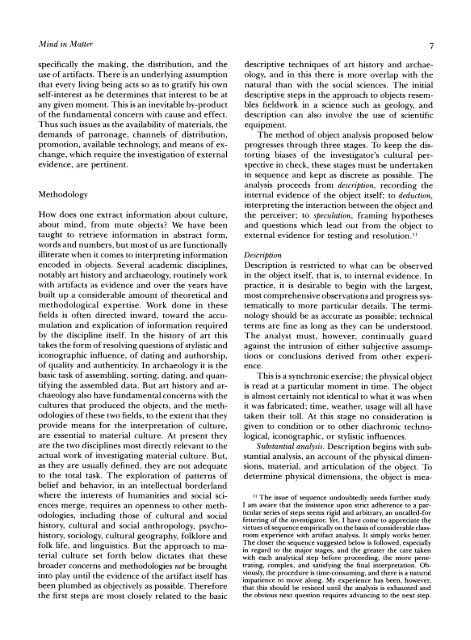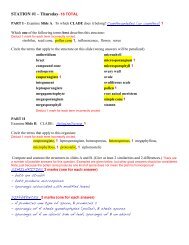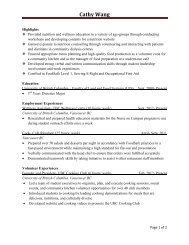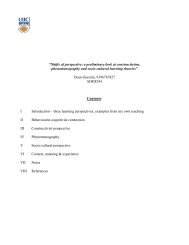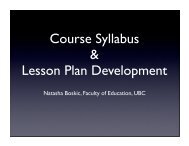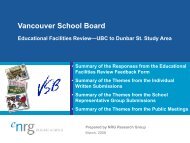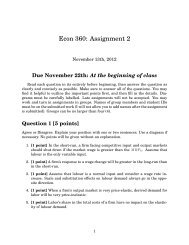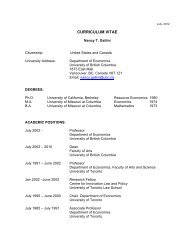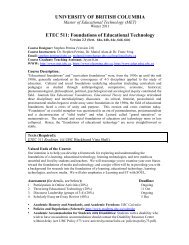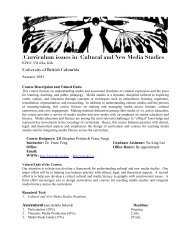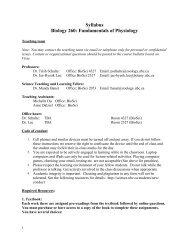Mind in Matter: An Introduction to Material Culture ... - UBC Blogs
Mind in Matter: An Introduction to Material Culture ... - UBC Blogs
Mind in Matter: An Introduction to Material Culture ... - UBC Blogs
You also want an ePaper? Increase the reach of your titles
YUMPU automatically turns print PDFs into web optimized ePapers that Google loves.
<strong>M<strong>in</strong>d</strong> <strong>in</strong> <strong>Matter</strong>specifically the mak<strong>in</strong>g, the distribution, and theuse of artifacts. There is an underly<strong>in</strong>g assumptionthat every liv<strong>in</strong>g be<strong>in</strong>g acts so as <strong>to</strong> gratify his ownself-<strong>in</strong>terest as he determ<strong>in</strong>es that <strong>in</strong>terest <strong>to</strong> be atany given moment. This is an <strong>in</strong>evitable by-produc<strong>to</strong>f the fundamental concern with cause and effect.Thus such issues as the availability of materials, thedemands of patronage, channels of distribution,promotion, available technology, and means of exchange,which require the <strong>in</strong>vestigation of externalevidence, are pert<strong>in</strong>ent.MethodologyHow does one extract <strong>in</strong>formation about culture,about m<strong>in</strong>d, from mute objects? We have beentaught <strong>to</strong> retrieve <strong>in</strong>formation <strong>in</strong> abstract form,words and numbers, but most of us are functionallyilliterate when it comes <strong>to</strong> <strong>in</strong>terpret<strong>in</strong>g <strong>in</strong>formationencoded <strong>in</strong> objects. Several academic discipl<strong>in</strong>es,notably art his<strong>to</strong>ry and archaeology, rout<strong>in</strong>ely workwith artifacts as evidence and over the years havebuilt up a considerable amount of theoretical andmethodological expertise. Work done <strong>in</strong> thesefields is often directed <strong>in</strong>ward, <strong>to</strong>ward the accumulationand explication of <strong>in</strong>formation requiredby the discipl<strong>in</strong>e itself. In the his<strong>to</strong>ry of art thistakes the form of resolv<strong>in</strong>g questions of stylistic andiconographic <strong>in</strong>fluence, of dat<strong>in</strong>g and authorship,of quality and authenticity. In archaeology it is thebasic task of assembl<strong>in</strong>g, sort<strong>in</strong>g, dat<strong>in</strong>g, and quantify<strong>in</strong>gthe assembled data. But art his<strong>to</strong>ry and archaeologyalso have fundamental concerns with thecultures that produced the objects, and the methodologiesof these two fields, <strong>to</strong> the extent that theyprovide means for the <strong>in</strong>terpretation of culture,are essential <strong>to</strong> material culture. At present theyare the two discipl<strong>in</strong>es most directly relevant <strong>to</strong> theactual work of <strong>in</strong>vestigat<strong>in</strong>g material culture. But,as they are usually def<strong>in</strong>ed, they are not adequate<strong>to</strong> the <strong>to</strong>tal task. The exploration of patterns ofbelief and behavior, <strong>in</strong> an <strong>in</strong>tellectual borderlandwhere the <strong>in</strong>terests of humanities and social sciencesmerge, requires an openness <strong>to</strong> other methodologies,<strong>in</strong>clud<strong>in</strong>g those of cultural and socialhis<strong>to</strong>ry, cultural and social anthropology, psychohis<strong>to</strong>ry,sociology, cultural geography, folklore andfolk life, and l<strong>in</strong>guistics. But the approach <strong>to</strong> materialculture set forth below dictates that thesebroader concerns and methodologies not be brought<strong>in</strong><strong>to</strong> play until the evidence of the artifact itself hasbeen plumbed as objectively as possible. Thereforethe first steps are most closely related <strong>to</strong> the basicdescriptive techniques of art his<strong>to</strong>ry and archaeology,and <strong>in</strong> this there is more overlap with thenatural than with the social sciences. The <strong>in</strong>itialdescriptive steps <strong>in</strong> the approach <strong>to</strong> objects resemblesfieldwork <strong>in</strong> a science such as geology, anddescription can also <strong>in</strong>volve the use of scientificequipment.The method of object analysis proposed belowprogresses through three stages. To keep the dis<strong>to</strong>rt<strong>in</strong>gbiases of the <strong>in</strong>vestiga<strong>to</strong>r's cultural perspective<strong>in</strong> check, these stages must be undertaken<strong>in</strong> sequence and kept as discrete as possible. Theanalysis proceeds from description, record<strong>in</strong>g the<strong>in</strong>ternal evidence of the object itself; <strong>to</strong> deduction,<strong>in</strong>terpret<strong>in</strong>g the <strong>in</strong>teraction between the object andthe perceiver; <strong>to</strong> speculation, fram<strong>in</strong>g hypothesesand questions which lead out from the object <strong>to</strong>external evidence for test<strong>in</strong>g and resolution."DescriptionDescription is restricted <strong>to</strong> what can be observed<strong>in</strong> the object itself, that is, <strong>to</strong> <strong>in</strong>ternal evidence. Inpractice, it is desirable <strong>to</strong> beg<strong>in</strong> with the largest,most comprehensive observations and progress systematically<strong>to</strong> more particular details. The term<strong>in</strong>ologyshould be as accurate as possible; technicalterms are f<strong>in</strong>e as long as they can be unders<strong>to</strong>od.The analyst must, however, cont<strong>in</strong>ually guardaga<strong>in</strong>st the <strong>in</strong>trusion of either subjective assumptionsor conclusions derived from other experience.This is a synchronic exercise; the physical objectis read at a particular moment <strong>in</strong> time. The objectis almost certa<strong>in</strong>ly not identical <strong>to</strong> what it was whenit was fabricated; time, weather, usage will all havetaken their <strong>to</strong>ll. At this stage no consideration isgiven <strong>to</strong> condition or <strong>to</strong> other diachronic technological,iconographic, or stylistic <strong>in</strong>fluences.Substantial analysis. Description beg<strong>in</strong>s with substantialanalysis, an account of the physical dimensions,material, and articulation of the object. Todeterm<strong>in</strong>e physical dimensions, the object is mea-1 The issue of sequence undoubtedly needs further study.I am aware that the <strong>in</strong>sistence upon strict adherence <strong>to</strong> a particularseries of steps seems rigid and arbitrary, an uncalled-forfetter<strong>in</strong>g of the <strong>in</strong>vestiga<strong>to</strong>r. Yet, I have come <strong>to</strong> appreciate thevirtues of sequence empirically on the basis of considerable classroomexperience with artifact analysis. It simply works better.The closer the sequence suggested below is followed, especially<strong>in</strong> regard <strong>to</strong> the major stages, and the greater the care takenwith each analytical step before proceed<strong>in</strong>g, the more penetrat<strong>in</strong>g,complex, and satisfy<strong>in</strong>g the f<strong>in</strong>al <strong>in</strong>terpretation. Obviously,the procedure is time-consum<strong>in</strong>g, and there is a naturalimpatience <strong>to</strong> move along. My experience has been, however,that this should be resisted until the analysis is exhausted andthe obvious next question requires advanc<strong>in</strong>g <strong>to</strong> the next step.7


